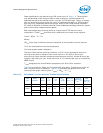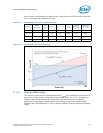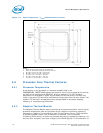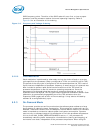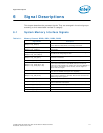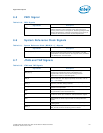
Thermal Management Specifications
114 Intel® Xeon® Processor E5-1600 v2/E5-2600 v2 Product Families
Datasheet Volume One of Two
asserted, all processor supplies (VCC, VTTA, VTTD, VSA, VCCPLL, VCCD) must be
removed within the timeframe provided. The temperature at which THERMTRIP_N
asserts is not user configurable and is not software visible.
5.2.6 Integrated Memory Controller (IMC) Thermal Features
5.2.6.1 DRAM Throttling Options
The Integrated Memory Controller (IMC) has two, independent mechanisms that cause
system memory throttling:
• Open Loop Thermal Throttling (OLTT) and Hybrid OLTT (OLTT_Hybrid)
• Closed Loop Thermal Throttling (CLTT) and Hybrid CLTT (CLTT_Hybrid)
5.2.6.1.1 Open Loop Thermal Throttling (OLTT)
Pure energy based estimation for systems with no BMC or Intel® Management Engine
(Intel® ME). No memory temperature information is provided by the platform or
DIMMs. The CPU is informed of the ambient temperature estimate by the BIOS or by a
device via the PECI interface. DIMM temperature estimates and bandwidth control are
monitored and managed by the PCU on a per rank basis.
5.2.6.1.2 Hybrid Open Loop Thermal Throttling (OLTT_Hybrid)
Temperature information is provided by the platform (for example, BMC or Intel ME)
through PECI and the PCU interpolates gaps with energy based estimations.
5.2.6.1.3 Closed Loop Thermal Throttling (CLTT)
The processor periodically samples temperatures from the DIMM TSoD devices over a
programmable interval. The PCU determines the hottest DIMM rank from TSoD data
and informs the integrated memory controller for use in bandwidth throttling decisions.
5.2.6.2 Hybrid Closed Loop Thermal Throttling (CLTT_Hybrid)
The processor periodically samples temperature from the DIMM TSoD devices over a
programmable interval and interpolates gaps or the BMC/Intel ME samples a
motherboard thermal sensor in the memory subsection and provides this data to the
PCU via the PECI interface. This data is combined with an energy based estimations
calculated by the PCU. When needed, system memory is then throttled using CAS
bandwidth control. The processor supports dynamic reprogramming of the memory
thermal limits based on system thermal state by the BMC or Intel ME.
5.2.6.3 MEM_HOT_C01_N and MEM_HOT_C23_N Signal
The processor includes a pair of new bi-directional memory thermal status signals
useful for manageability schemes. Each signal presents and receives thermal status for
a pair of memory channels (channels 0 & 1 and channels 2 & 3).
• Input Function: The processor can periodically sense the MEM_HOT_{C01/C23}_N
signals to detect if the platform is requesting a memory throttling event.
Manageability hardware could drive this signal due to a memory voltage regulator
thermal or electrical issue or because of a detected system thermal event (for
example, fan is going to fail) other system devices are exceeding their thermal
target. The input sense period of these signals are programmable, 100
us is the
default value. The input sense assertion time recognized by the processor is
programmable, 1
us is the default value. If the sense assertion time is programmed




